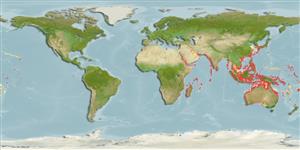Common names from other countries
Classification / Names / Names
Common names | Synonyms | Catalog of Fishes (gen., sp.) | ITIS | CoL | WoRMS
Environment: milieu / climate zone / depth range / distribution range
Ecology
Benthic; depth range 0 - 50 m (Ref. 348). Tropical; 35°N - 37°S, 29°E - 154°W
Indo-West Pacific: from East and southeast Africa, including Madagascar, Mauritius Island, the Red Sea and the Persian Gulf, to New Caledonia; north to Japan and south to South Australia. Generally absent from oceanic islands of the central Indian Ocean and the tropical West Pacific, but sporadically found in Hawaii.
Length at first maturity / Size / Weight / Age
Maturity: Lm ? range ? - ? cm Max length : 50.0 cm SHL male/unsexed; (Ref. 348); common length : 40.0 cm SHL male/unsexed; (Ref. 348); max. reported age: 18 years (Ref. 107096)
Species of minor economic importance, and collected for subsistence fisheries (Ref. 348). Maximum depth from Ref. 101118.
Life cycle and mating behavior
Maturity | Reproduction | Spawning | Eggs | Fecundity | Larvae
Planktonic larval stage (Ref. 348).
Poutiers, J.M. 1998. (Ref. 348)
IUCN Red List Status (Ref. 130435: Version 2024-1)
CITES status (Ref. 108899)
Not Evaluated
Not Evaluated
Human uses
Fisheries: commercial
| FishSource | Sea Around Us
Tools
Internet sources
Estimates based on models
Preferred temperature
(Ref.
115969): 18.7 - 29.1, mean 27.9 (based on 1460 cells).
Resilience
High, minimum population doubling time less than 15 months (K=0.88).
Prior r = 0.84, 95% CL = 0.56 - 1.27, Based on 1 data-limited stock assessment.
Vulnerability
Moderate vulnerability (38 of 100).
Price category
Unknown.
